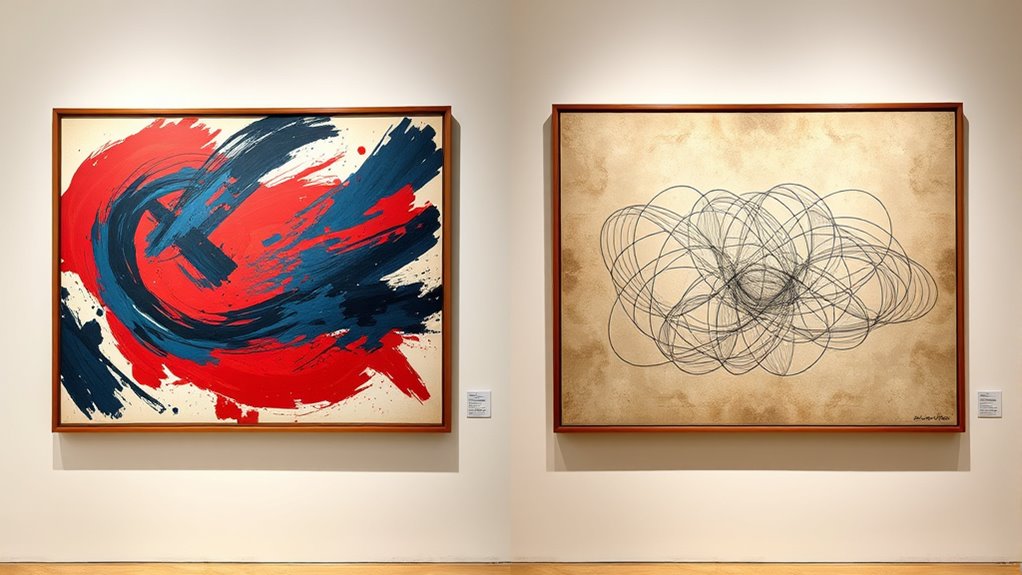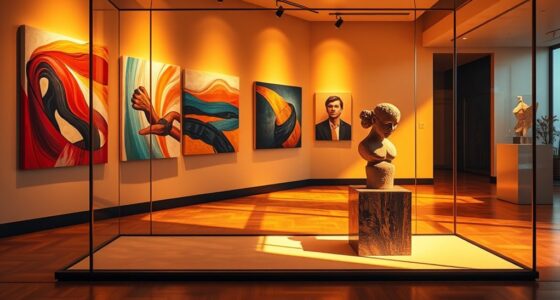Studying artworks side by side helps you compare techniques, styles, and cultural influences more effectively. By examining brushwork, color use, and composition, you can identify what sets each piece apart and how artists express their ideas. Recognizing different styles reveals historical shifts and creative innovations. Noticing themes and messaging offers deeper insight into the artist’s intent and context. Keep exploring these connections, and you’ll uncover even richer layers of understanding.
Key Takeaways
- Analyze brushwork, color use, and composition to identify stylistic differences and artistic techniques.
- Compare thematic content and historical context to understand cultural influences and artistic evolution.
- Examine materials and layered meanings to interpret artistic intent and emotional impact.
- Assess visual elements like contrast and color theory to evaluate message clarity and mood.
- Consider digital reproduction factors to ensure accurate side-by-side visual comparison.

When comparing artworks, you gain deeper insights into the artist’s intentions, techniques, and cultural influences. This process allows you to see beyond the surface and understand the choices made in each piece. One of the most effective ways to do this is through techniques comparison. By examining brushwork, use of color, composition, and materials, you can identify how artists achieved their effects and what their style reveals about their creative process. For instance, a classical painting might feature smooth, meticulous brushstrokes, reflecting a focus on realism, while an abstract piece might use bold, sweeping strokes to evoke emotion. Comparing these techniques helps you appreciate the skill involved and the artistic goals behind each work. Additionally, recognizing artistic styles can help you categorize and better understand the evolution of artistic expression over time. In addition to technique, considering the historical context enriches your understanding. Art doesn’t exist in a vacuum; it responds to and influences its time. When studying two artworks side by side, think about the period in which each was created. Was the artist commenting on social upheaval, religious themes, or political change? For example, comparing Renaissance art with modern abstract art reveals differences rooted in their respective eras. The Renaissance emphasized realism and humanism, driven by a renewed interest in classical knowledge, while modern art often reflects the complexities of contemporary life and experimentation. Recognizing these historical influences allows you to see why certain themes, styles, or techniques emerged and how they shaped the artwork’s message. By combining techniques comparison with an understanding of the historical context, you deepen your analysis. You start to grasp how artists responded to their surroundings and how their technical choices conveyed specific ideas or emotions. For example, a Baroque painting’s dramatic lighting and movement can be linked to the Counter-Reformation’s emphasis on emotional engagement and religious fervor. Meanwhile, a post-impressionist work might use vivid colors and distorted forms to express personal perception and innovation. These connections help you appreciate the layered meanings behind each piece. Furthermore, understanding the contrast ratio and its impact on image quality can inform how viewers interpret visual artworks, especially in digital reproductions or displays. A knowledge of color theory can also enhance your understanding of how artists use color to communicate mood and symbolism. Also, understanding visual clarity in artwork presentation can influence how effectively the artist’s message is conveyed to the viewer. Ultimately, comparing artworks side by side isn’t just about spotting differences; it’s about uncovering the story behind each creation. The more you learn about techniques and historical context, the more you can interpret what the artist intended and what they sought to communicate. This active engagement turns viewing art into a dynamic dialogue, bringing you closer to understanding the cultural and personal narratives that shape each masterpiece.
Frequently Asked Questions
How Do Cultural Differences Influence Comparative Artwork Analysis?
When considering how cultural differences influence comparative artwork analysis, you see that cultural symbolism shapes your interpretation and aesthetic perceptions. You recognize that symbols and themes hold different meanings across cultures, affecting how you perceive an artwork’s message. By understanding these cultural nuances, you gain deeper insight, allowing you to appreciate diverse artistic expressions more fully and avoid misinterpretations caused by your own cultural lens.
What Role Does Historical Context Play in Comparisons?
Think of history as the stage where artworks perform. It shapes your understanding of artistic intent and visual symbolism, revealing why artists chose certain themes or styles. When you compare pieces across eras, you see how historical events, societal shifts, and cultural movements influence their meaning. This context helps you grasp deeper layers of each work, allowing you to appreciate how history and art intertwine, enriching your interpretation.
How Can Subjective Opinions Be Balanced With Objective Criteria?
You can balance subjective opinions with objective criteria by recognizing your personal bias and applying criteria standardization. Focus on clear, consistent standards like composition, technique, and historical significance. While personal feelings influence your views, grounding your evaluation in these established criteria guarantees fairness. This approach helps you appreciate diverse perspectives while maintaining a structured, balanced critique, making your analysis both personal and objectively meaningful.
Are There Specific Techniques for Comparing Abstract Artworks?
Imagine peeling back layers of a vibrant, complex onion—comparing abstract artworks requires a delicate touch. You focus on color theory to understand emotion and mood, and use compositional analysis to see how shapes and lines guide your eye. By examining these elements side by side, you uncover hidden harmonies or contrasts, helping you appreciate each piece’s unique language. This technique transforms subjective impressions into a structured, insightful exploration.
How Does Technology Impact Modern Comparative Art Studies?
Technology transforms modern art studies by providing digital tools that make analysis more accessible and detailed. You can explore virtual exhibitions from around the world, allowing you to compare artworks side by side without physical limitations. Digital tools enable you to zoom in on details, analyze textures, and examine color schemes precisely. This connectivity and enhanced access help you gain deeper insights, making your comparative studies more thorough and engaging.
Conclusion
By comparing artworks side by side, you gain a deeper understanding of artistic evolution and cultural influences. For example, examining Picasso’s “Les Demoiselles d’Avignon” alongside African tribal masks reveals how different cultures inspire innovation. This approach not only sharpens your analytical skills but also enriches your appreciation for artistry’s diversity. So, next time you study art, remember that seeing works together can uncover hidden stories and connections you might otherwise miss.









